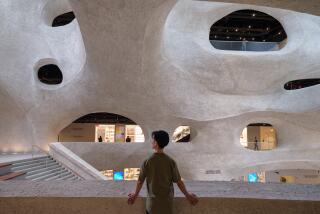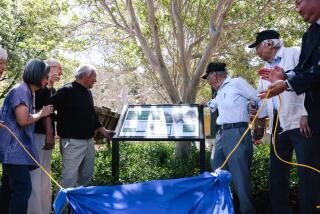Art of Frozen Land Comes to Life : Museum: The traveling U.S.-Soviet exhibition is a visual feast, the story of an unvisited past.
- Share via
Images of an isolated culture:
Carved faces that fishermen fixed to their boats to bring luck. Hats of ivory and wood to lend strength to the hunter. A funeral coat of seal fur and tassels, meant to placate the dogs that guard the Land of the Dead.
For thousands of years, the people of the North Pacific flourished in a frozen land. These Siberians, Aleuts and Eskimos were ignored by peoples that inhabited warmer climes to the south.
When European explorers traveled north, beginning in the mid-1700s, they were astonished by the sophistication and beauty they found in large villages in the North Pacific. Researchers began to collect artifacts and piece together a history of this region.
But it wasn’t until recently that the two countries with the largest North Pacific collections--the Soviet Union and United States--agreed to share their knowledge. The result is “Crossroads of Continents,” a traveling Smithsonian Institution exhibition now at the Gene Autry Western Heritage Museum in Griffith Park.
More than 600 artifacts are displayed, including clothing and jewelry, tools and weapons, toys and ceremonial regalia. The art of the North Pacific is seen in the design and decoration of everyday items. The exhibit is a visual feast, the story of an unvisited past.
“Scientists call the North Pacific the ‘Mediterranean of the Arctic,’ ” said James H. Nottage, the Autry’s chief curator. “It has a rich and complex culture.”
The culture is also quite foreign, with images of animal gods and shamanistic ritual. And because aging and delicate artifacts would be damaged by bright light, the exhibit space is eerily dark.
You see a St. Lawrence Island warrior with his wing-like shield and armored skirt. You see the salmon-skin coat of the Nanai people, appliqued with figures drawn from Chinese mythology (a visual remnant of the time when, thousands of years ago, Asians walked to the New World across the temporarily dry Bering Strait).
Preparations for “Crossroads” began in 1977, when anthropologists from the Smithsonian and the Soviet Academy of Sciences agreed to join forces on the project. They gathered artifacts from the Museum of Anthropology and Ethnography in Leningrad, the Smithsonian, the American Museum of Natural History in New York City and other museums in the United States and Canada.
Many of the items had never before been shown in North America. Some had remained in storage for hundreds of years, since the earliest explorations of the North Pacific.
Scientists also collaborated on a summary film that portrays 20th-Century developments in Siberian and Alaskan cultures.
The exhibit opened at the Smithsonian in Washington, D.C., and will move on to Anchorage, Ottawa and Leningrad. It has stopped over at the Autry as part of an ongoing relationship between the Smithsonian and the Griffith Park museum.
In conjunction with the main exhibit, a “hands-on” exhibit has opened in an ancillary gallery. Children can touch and play with numerous replicas, including a Northwest Coast Indian long house and a large variety of bird and animal replicas.
“Crossroads of Continents” continues through Feb. 24. The Gene Autry Western Heritage Museum is at 4700 Zoo Drive. Hours are 10 a.m. to 5 p.m. Tuesday through Sunday. Admission to this exhibit is $7.50, $6 for seniors and students, $4.50 for children under 13. For information call (213) 667-2000.
More to Read
The biggest entertainment stories
Get our big stories about Hollywood, film, television, music, arts, culture and more right in your inbox as soon as they publish.
You may occasionally receive promotional content from the Los Angeles Times.











